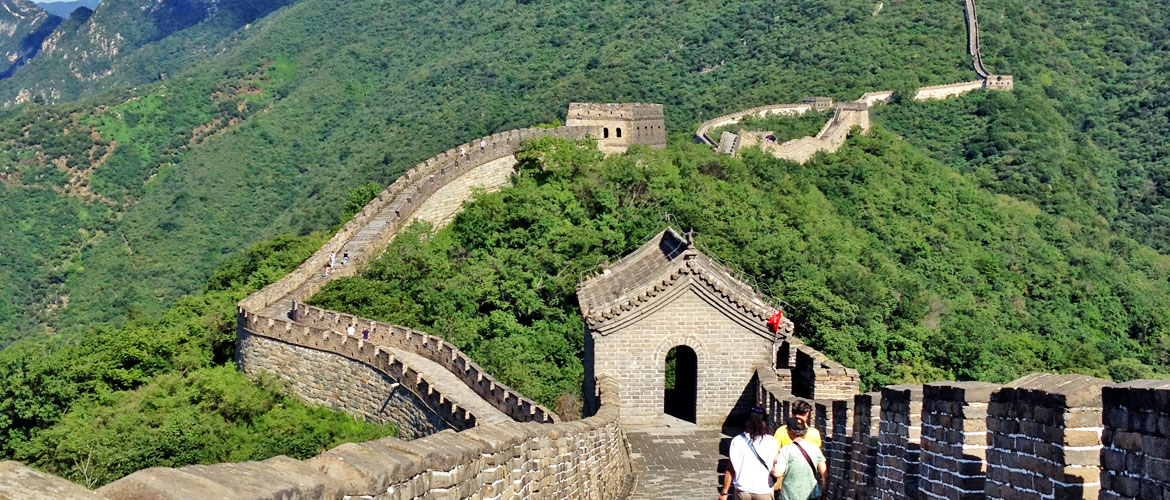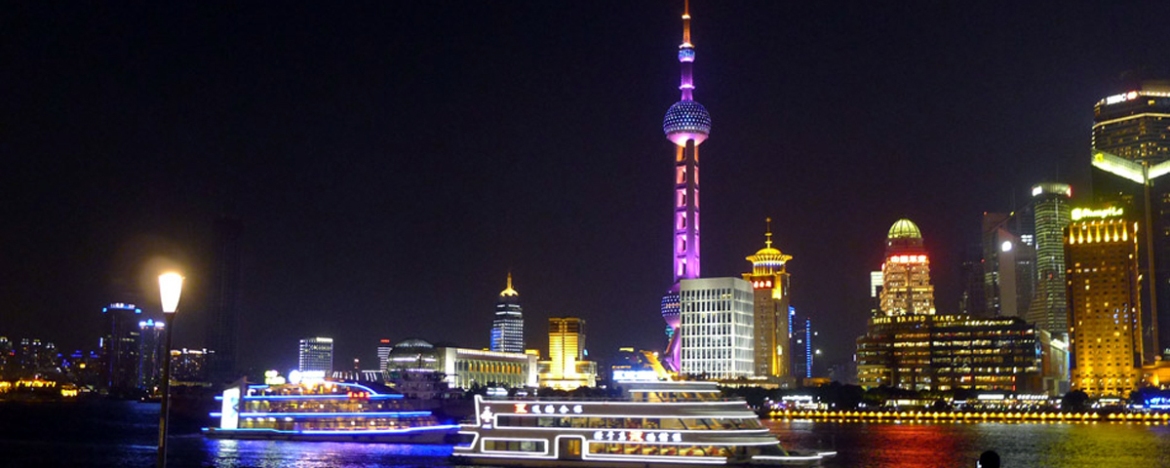Beijing – Chengdu – Yangtze Cruise – Yichang – Shanghai
Join us on this luxury China trip and get pampered! Explore ancient sites in Beijing and Chengdu, marvel at the grandeur of the Yangtze River, and savour authentic Chinese cuisine at quality restaurants – this tour lets you do all that and much more.
Important Features
- Small group size – average 15, maximum 20
- Expert guides handpicked by company owners
- No annoying forced shopping of any kind
- Quality meals at non-tourist restaurants
- Unlimited supply of bottled water during group activities
- Deluxe cabin with private balcony on luxury Yangtze cruise
- Free Wi-Fi in all hotels
- Great Wall visit at Mutianyu with cable car rides
Options Available
- Peking Opera show in Beijing
- Traditional face mask changing performance in Chengdu
- Half-day Jewish heritage tour in Shanghai
- 2-day post-tour Yellow Mountain extension
Meal Code: B = breakfast / L = lunch / D = dinner
Day 1/Sat: Departing for Beijing
The trip starts with your transpacific flight departing from a city of your choice. You’ll lose a day upon crossing the International Date Line.
Day 2/Sun: Arrival in Beijing
Meet the driver on arrival for transfer to the hotel. You’ll have the remainder of the day at leisure. The guide will get in touch with you tonight.
Day 3/Mon: Beijing (B/L/D)
The capital of China, Beijing is a world-class cultural and educational centre with a population of 21.9 million (2020), ranking it China’s second largest city behind Shanghai. Beijing is renowned for its opulent palaces, temples, and huge stone walls and gates – treasures that make it the most popular tourist city in China by the number of visitors it receives every year.
We begin today with a visit to the Forbidden City. Officially known as the Palace Museum, the Forbidden City was the place where the emperors of the Ming (1368-1644) and Qing (1644-1912) dynasties lived and carried out their administration. Construction of the Forbidden City took 14 years (1406-1420) to complete. The complex consists of 980 buildings and covers 72 hectares or 180 acres. It exemplifies traditional Chinese palatial architecture and has influenced cultural and architectural developments in East Asia and elsewhere. Though the Qing Dynasty was overthrown in 1912, the royal family was allowed to continue to live in the Forbidden City till 1924, when the last emperor, Pu Yi, was driven out of the imperial palace. One year later the Forbidden City was turned into a museum. Declared a World Heritage Site by UNESCO in 1987, this is the largest collection of preserved ancient wooden structures in the world.
Next up is Tian’anmen Square. Located in the heart of Beijing, the square measures 880 metres from north to south and 500 meters from east to west. Said to be the largest public plaza in the world, Tian’anmen Square has the capacity to hold one million people. The imposing Tian’anmen Tower sits at the north end of the square while the Monument to the People’s Heroes dominates the centre. The square is flanked by The Great Hall of the People (west) and the National Museum (east). Chairman Mao’s Mausoleum and Qianmen (Front Gate) are located in the south of the square. One of the top 16 tourist attractions in Beijing, Tian’anmen Square is also the witness of the Chinese people’s great struggles for democracy and personal freedom since 1919.
Afternoon sightseeing takes place at the Temple of Heaven, another UNESCO World Heritage Site. Situated in southeastern Beijing, the Temple of Heaven is China’s largest extant sacrificial temple where, during the Ming and Qing Dynasties, the emperors conducted the elaborate and most exalted sacrifices addressed to “the Supreme Ruler of the Universe.” Construction of the temple started in 1406, during the reign of the Ming Emperor Yongle, and took 14 years to complete. The temple was expanded under the Qing emperors Qianlong (1736-1796) and Jiaqing (1796-1820). Occupying 2.73 square kilometres (roughly 1,700 by 1,600 metres), the area of the Temple of Heaven is more than twice that of the Forbidden City.
The famous Hongqiao Pearl Market, the largest pearl market in the world, is right across the street from the Temple of Heaven. Recommended by numerous guidebooks for freshwater pearls, Hongqiao teems with domestic and international shoppers. If you are interested, please ask the guide to drop you off there. However, you’ll need to get back to the hotel by taxi, which costs about 8 US dollars.
Today we enjoy a delicious dinner at a popular Peking Roast Duck restaurant. Peking Roast Duck is a famous Beijing dish prized for the thin and crispy skin with authentic versions serving mostly the skin and little meat, sliced in front of the diners. The meat is wrapped in a thin layer of pancake (Chinese tortilla) together with shredded scallion, cucumber, and a sweet and salty sauce made of wheat flour. Condiments may also include pickled garlic and white sugar.
Day 4/Tue: Beijing (B/L)
After an early breakfast we embark on a full-day excursion to the legendary Great Wall at Mutianyu, 75 km northeast of the city.
Zigzagging over 6,000 kilometres from east to west along the undulating mountains, the Great Wall was built to hold off tribal invaders from the north. As history shows, the Wall failed the Chinese rulers miserably, especially in the case of Kublai Khan who and his men swept across China from the Mongolian steppe, thus the beginning of the Yuan Dynasty (1279-1368).
Construction of the earliest sections of the Wall started in the 7th century BCE. A major renovation started with the founding of the Ming Dynasty in 1368 and took 200 years to complete. The wall we see today in Beijing is almost exactly the result of this effort.
Day 5/Wed: Beijing – Chengdu (B/L)
We begin our sightseeing today with a visit to a traditional hutong neighbourhood. Hutong refers to an ancient alleyway with siheyuan or ”4-sided courtyard house” on both sides. The name hutong dates back to the Yuan Dynasty (1279 – 1368 CE). According to some experts, the word originated from the Mongolian language, in which it is pronounced as hottog and means “well.” In ancient times, people tended to gather and live around wells. So the original meaning of hutong should be “a place where people live around”.
Next on our schedule is the Summer Palace, a well preserved UNESCO World Cultural Heritage Site. The imperial resort was first named Garden of Clear Ripples, which was burnt down by the allied forces of Great Britain and France in 1860 at the end of the Second Opium War (referred to as Arrow War by the British). Reconstruction started 25 years later and was completed in 1895 when the name was changed to Yi He Yuan (Garden of Good Health and Harmony). The design gives prominence to Longevity Hill, as well as Kunming Lake south of the hill. The sprawling complex covers an area of 290 hectares and the buildings inside consist of over 3,000 bays.
The late afternoon flight to Chengdu takes about three hours.
Day 6/Thu: Chengdu (B/L)
Morning sightseeing at Chengdu Research Base of Giant Panda Breeding. The giant panda, unrelated to the red or lesser panda, is a bear native to south central China, living in mountainous regions. It is easily recognized by the large, distinctive black patches around its eyes, over the ears, and across its round body. Though it belongs to the order Carnivora, the panda’s diet is over 99% bamboo. The giant panda has an insatiable appetite for bamboo. A typical animal eats half the day – a full 12 out of every 24 hours – and relieves itself dozens of times a day. Giant pandas are solitary creatures. They have a highly developed sense of smell that males use to avoid each other and to find females for mating in the spring. After a five-month pregnancy, females give birth to a cub or two, though they cannot care for both twins. The blind infants, born fully white, weigh only 5 ounces (142 grams) at birth and cannot crawl until they reach three months of age.
The panda is a conservation reliant endangered species. Recent statistics (late 2022) shows 637 pandas living in captivity with most of them inside China. The most authoritative estimate as of late 2022 puts the number of giant pandas living in the wilderness at 1864.
We spend most of the afternoon at Jinsha Museum. In February 2001, construction workers chanced upon a significant archaeological discovery in modern China. The discovery led to the naming of Jinsha culture (1200 – 650 BCE) and a museum was erected at the excavation site. Jinsha culture flourished around 1000 BCE and shares similarities in burial objects with the Sanxingdui site located 50 km from Chengdu. Objects made of ivory, jade, bronze, gold and stone were unearthed at the site. Unlike the site at Sanxingdui, Jinsha did not have a city wall. Jinsha culture is believed to be a final phase of Sanxingdui civilization and represents a relocation of the political center in the ancient Shu Kingdom.
Day 7/Fri: Chengdu – Chongqing (B/L/D)
Free morning to explore on your own.
Afternoon sightseeing following lunch includes Wang Jiang Lou Park and a typical local tea house. “Wang Jiang Lou” means “river-overlooking tower” and the park is so named because of the ancient pagoda-shaped wooden tower onsite. The beautiful little park dotted with verdant bamboo groves has long been a favourite spot among locals for leisure.
We ride the bullet train (G2889, 16:10/17:43) to Chongqing where we board the Yangtze cruise ship following dinner.
Day 8/Sat: Yangtze Cruise (B/L/D)
At 6,380 km the Yangtze is the longest river in China and the third longest in the world after the Nile and the Amazon. The most impressive section of the Yangtze is the Three Gorges stretching 119 km.
On today’s shore excursion we visit Precious Stone Fortress (shi bao zhai) built atop a hill overlooking the Yangtze. It was so named because the location was once used as a stronghold by a group of uprising peasants in the mid-17th century. About one hundred years later a Buddhist temple was built on the hill. Several more decades passed before a staircase covered by a 9-storey wooden pagoda was added. In 1956, the pagoda was expanded to the current 12 storeys.
Day 9/Sun: Yangtze Cruise (B/L/D)
Admire nature’s grandeur while sailing through spectacular Wu Gorge (45 km) and Qutang Gorge (8 km). Later this morning we hop on a small vessel to explore Goddess Stream. A tributary of the Yangtze, the emerald-coloured stream traverses through narrow gorges walled by soaring cliffs.
Day 10/Mon: Yichang – Shanghai (B/L)
Morning visit to the Three Gorges Dam site. This is the largest hydroelectric dam in the world with a reservoir stretching hundreds of kilometres upstream.
We disembark the ship at noon and travel to Shanghai by high-speed train (D954, 14:06/20:21). The journey is 6 hours long but the big seat in first class should make it a very comfortable one. If you forget to buy snacks for the train journey, you can always find some to buy on the train.
Day 11/Tue: Shanghai (B/L/D)
With a population of 24.9 million (2021), Shanghai is China’s largest city, which delights the visitor with its futuristic skyline and historical landmarks. As China’s leading gateway to the world, Shanghai plays a prominent global role as a hub of commerce, finance, cultural exchange, fashion, technology and transport.
We begin our day with a visit to Jade Buddha Temple located in an old neighbourhood. Later on we tour the famous waterfront promenade known as the Bund, which is followed by the Yu Garden in the old town centre. We wrap up the day with a drive through the glitzy financial district of Lujiazui on the opposite side of the Bund across Huangpu River.
Day 12/Wed: Shanghai (B)
Today is set aside to explore on your own. An optional day trip to Tongli (ancient water town) or Suzhou may be ideal. If you want to spend the time exploring Shanghai, we’d recommend Shanghai Museum and the Urban Planning Exhibition Center nearby. Shanghai Museum, a great place to explore on your own, is frequently cited by visitors as one of the best of its kind in China with a huge collection of national treasures.
Day 13/Thu: Shanghai – Home City (B)
Your memorable China tour ends this morning. Transfer to the airport any time for return flight. Guests flying back to North America will regain a day upon re-crossing the International Date Line, thus arriving home the same day as departing from Shanghai.
| City | Nights | Hotel/Ship | Category |
| Beijing | 3 | New Otani Chang Fu Gong | Luxury/5 stars |
| Chengdu | 2 | Chengdu Taihe International | Luxury/5 stars |
| Yangtze Cruise | 3 | Victoria Cruises | Luxury/5 stars |
| Shanghai | 3 | Amara Signature Shanghai | Luxury/5 stars |
Dates & Prices
Prices are per person based on double occupancy.
| Depart (Sat) |
Return (Thu) |
Land Only* CA$/US$ |
Single Supplement CA$/US$ |
| 2025 Early Bird Discount |
|||
| 08-Mar | 20-Mar | $3,848/$2,850 | $1,350/$999 |
| 15-Mar | 27-Mar | $3,915/$2,900 | $1,418/$1050 |
| 22-Mar | 03-Apr | $3,983/$2,950 | $1,485/$1100 |
| 05-Apr | 17-Apr | $4,118/$3,050 | $1,688/$1250 |
| 12-Apr | 24-Apr | $4,253/$3,150 | $1,688/$1250 |
| 17-Apr | 01-May | $4,388/$3,250 | $1,688/$1250 |
| 03-May | 15-May | $4,388/$3,250 | $1,688/$1250 |
| 10-May | 22-May | $4,388/$3,250 | $1,688/$1250 |
* Land Only price does NOT international airfare. Please contact us for a fare quote.
** This departure starts in Shanghai and ends in Beijing. Contact us for itinerary.
|
What the tour price includes:
|
What the tour price excludes:
See Terms & Conditions for more information. |



